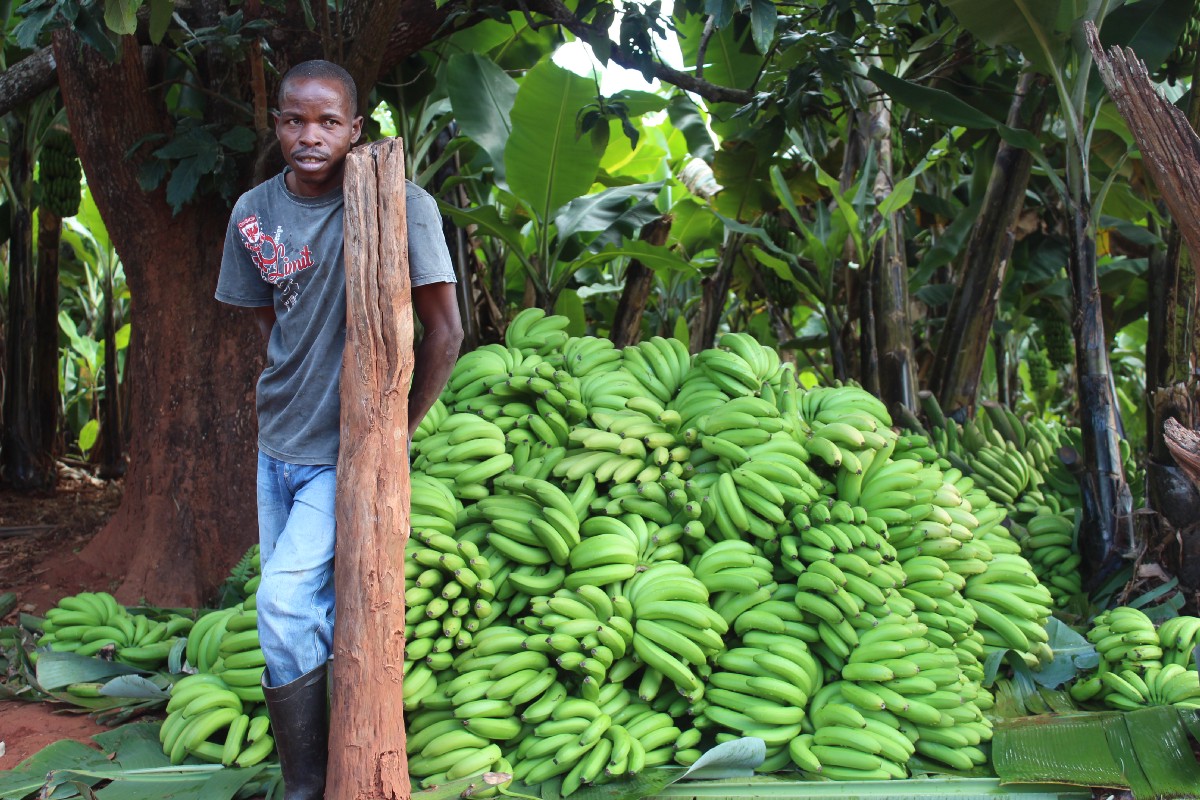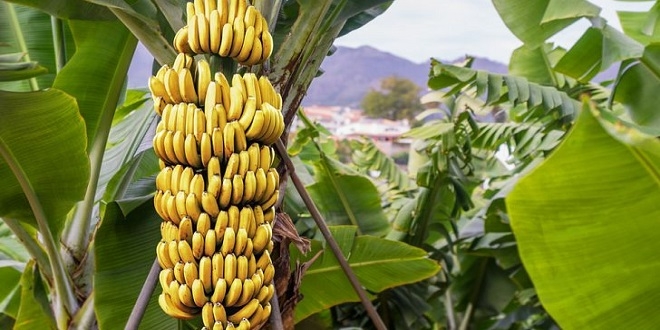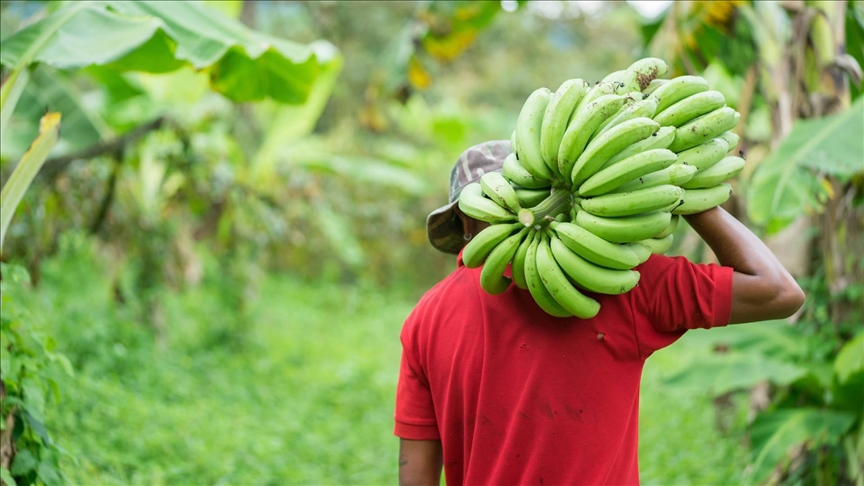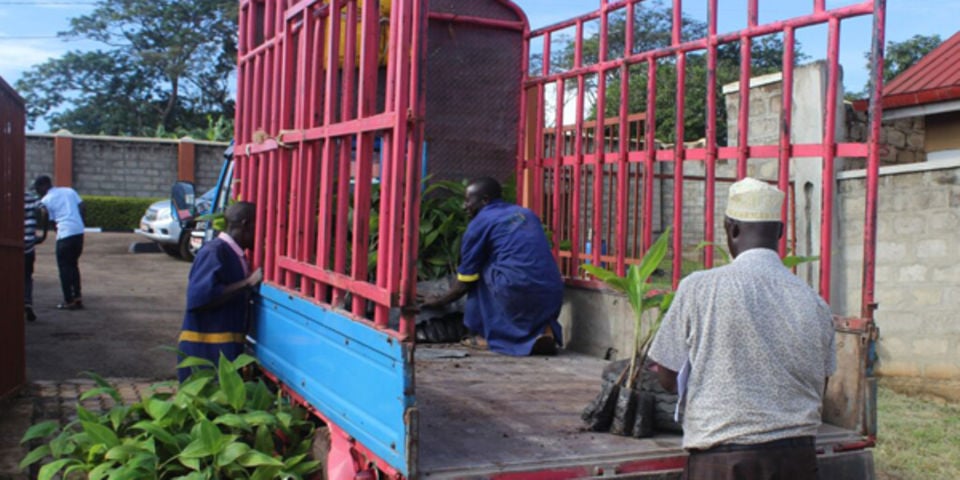BANANA VARIETIES
Ripening varieties: Gross Michel, Apple, Giant Cavandish, Dwarf Cavandish, Williams hybrid, Grand Nain, Vallery, paz, lacatan, Ugandan red, peripeta
Cooking Varieties:Ng’ombe, Ugandan green, Mutahato, GradiShisikame
Duo-purpose: Muraru, Gold Finger, Ng’ombe, Bokoboko, Mkono watembo
Agroecological conditions
Temperature
Altitudes of below 1800 m above sea level are generally recommended for the production of bananas.. For optimal growth, bananas require a warm humid climate. An average temperature of 20°C-30°C is required. At Below 20°C, normal plant growth is retarded. Lacatan and Valery tolerates cold weather better than other varieties. Cooler areas (higher altitudes) slow down plant development and the inflorescence may also fail to emerge.
Rainfall
Bananas can grow well with an annual rainfall of between 1000 and 2500 mm. optimal yields require a well distributed annual rainfall of 1400 mm or more, without long dry spells.
Land Preparation
Before planting, deep soil cultivation by ploughing and harrowing is recommended. The fields should be free of trees, bushes and especially perennial weeds
PLANTING
Should be done at the onset of rains. Under dry conditions dig holes 90cm by 90cm by 60cm, in wet areas dig the holes 60cm by 60cm by 60cm.
Spacing is done as follows:
- Short variety (Dwarf Cavendish, Giant Cavendish) 2.5m × 3m.
- Medium variety (Valery, Williams) 3.0m × 4.0m.
- Tall variety (Lacatan, Poyo) 4.0m× 4.0m.
Fertilizer and Manure Application
- At planting, about 150-200g of triple super phosphate (TSP) should be applied per plant.
- An early and good supply of nitrogen fertilizer is essential to accelerate the growth of pseudo-stems and faster flowering.
- To 250-300g of calcium ammonium nitrate (CAN) should be distributed around each stool per year, together with 125g of TSP, which is worked into the soil.
- 40-60kg of decomposed farmyard manure is applied per stool per year before the rains. This is applied on the outer diameter of the canopy. A short-forked hoe is used to incorporate the manure shallowly and carefully, to ensure no root damage.
Weeding
Cultivation should always be shallow because a banana plant is shallow rooted. If mechanical weeding is done, care should be taken to avoid any disturbance of the roots and the developing suckers.
Spacing
The spacing depends on the Soil fertility level, rainfall (water availability).
The following spacing is recommended under a five-year cycle on a fertile soil with adequate rainfall:
· Short variety (Dwarf Cavendish, Giant Cavendish) 2.5m × 3m.
· Medium variety (Valery, Williams) 3.0m × 4.0m.
· Tall variety (Lacatan, Poyo) 4.0m× 4.0m.
Planting Materials
Clean, healthy planting material consisting of side shoots, or pieces of corm with one to two eyes can be used.
Cutting back of the mature shoots encourages the production of side shoots.
Fertilizer and Manure Application
At planting, about 200 g of triple super phosphate (TSP) should be applied per plant. An early and good supply of nitrogen fertilizer is essential to accelerate the growth of pseudo-stems and faster flowering. To 300 g of calcium ammonium nitrate (CAN) should be distributed around each stool per year, together with 125 g of TSP, which is worked into the soil. Two to four debes of decomposed farmyard manure is applied per stem per year before the rains. This is applied on the outer diameter of the canopy. A short forked hoe is used to incorporate the manure shallowly and carefully, to ensure no root damage.
Weeding
Cultivation should always be shallow because a banana plant is shallow rooted. If mechanical weeding is done, care should be taken to avoid any disturbance of the roots and the developing suckers. Earthing up of the stem base is required in windy areas.
Mulching
Advantages of mulching:
- Suppress unwanted weed growth
- Retain moisture
- Provide humus for a good soil structure.
- Grass, banana leaves, or old pseudo-stems mulch can be used to return the nutrients to the soil. However, the use of old pseudo-stems can encourage banana weevil infestation. The stem should therefore be well chopped and allowed to dry before use.
Pruning and Proping
To provide bigger and higher quality bunches, bananas have to be de-suckered regularly to control any unwanted sucker growth. Only three pseudo-stems should be allowed to remain on each corm: one bearing one half grown, and one just sprouting.
Surplus suckers should be removed as early as possible in their development and perhaps used as planting material. Dead leaves should be removed at least twice a year. After harvesting, the pseudo-stem should be cut off from the plant at ground level.
Propping of the fruit bearing pseudo-stem should be done to prevent breakage caused by heavy bunches. Done with wood or bamboo, for bamboo requires digging a hole about 40 to 60 cm deep at the base of the stem to install the prop. Tie the bunch to the prop near the portion where the fruit stalk emerges from the stem. Y-sticks can also be used for staking. This helps avoid unnecessary logging of the stems especially due to massive fruiting
Soil Management
Several steps can be taken to replenish or increase soil nutrients; they include:
- Mulching of banana fields is a traditional agronomic practice favored for its suppression of weeds, conservation of moisture and maintenance of soil fertility. It also plays an important role in the control of soil erosion. This can be done through the following ways:
- Spreading pruned banana leaves and plant parts remaining after harvest on the plantation floor, supplemented with materials from crop fields, fallow fields, swamps and livestock manure.
- Household wastes are distributed near the homestead resulting in a soil fertility gradient that causes higher yields near the homestead and lower yields as the distance from the house increases.
- Intercropping of bananas with other crops is also a common soil fertility improvement effort, which when it occurs, is sometimes a secondary benefit to the primary purpose of the practice.
Intercropping
- Perennial crops such as coffee can be intercropped with bananas for the provision of shade especially at establishment. They also benefit the banana by recycling nutrients from deep capture, because of their rooting system, via litter fall.
- Bean is the annual crop most commonly associated with banana. The two crops are compatible in a multi-story system as bean does not compete with banana above ground and is more shade tolerant than most other food crops.
- Maize and sweet potatoes are intercropped with the young banana plants and are phased out at canopy closure.
- Fruit trees like jack fruit and papaw are established with the plantation as sources of fruit.
Irrigation
Water is needed particularly at flowering. Therefore, in drier areas supplemental irrigation may be necessary during this time. Some farmers are practicing 8drib/overhead irrigation methods. An overhead irrigation system (near the base of the plant)
Wind Break
Bananas are adversely affected by strong wind. Planting in sheltered positions and in blocks, rather than in strips, is recommended. If planted in blocks, the plants provide each other with some protection against the wind.
Fruit Protection
Skin blemishes can ruin the value of the banana bunch. The bract and stem leaves that may rub against the developing fruit need to be removed on a regular basis. The male flower bud is removed after it has grown 15 cm below the last hand. Bagging developing bunches with polythene bags can be done to protect the fruit. The bags can be clear or colored and are perforated to allow air circulation. Bagged fruit develops three to four days earlier.
Maturity/Harvesting
The time for planting to maturity of a banana depends on area and variety. A plant takes roughly 8 to 12 months to mature. Maturity indices vary widely among varieties. Angularities or fullness of fingers, as well as color change are some of the standard criteria used. Immature bananas are very angular but fill out to a rounded shape at full maturity. Fruits are ready for harvesting 90 – 150 days after fingers start to form. Fingers are considered mature for harvest when they are ¾ round (75% maturity)
Bananas are harvested green at varying stages of maturity depending on market requirement. While harvesting, bunches should never be allowed to fall on the ground after severing from the plant, to avoid fruit damage. For home consumption, the bunch is cut from the stem after fingers begin to turn light green and the edges of the fruit change from angular to round. Bananas harvested at this stage will ripen within one to two week’s time. After harvesting the bunch, the pseudo-stem is cut off with a clean implement at ground level. The cut is covered with soil to avoid easy entry by the banana weevil.
Yields
The average yield is 35 to 45 t/ha under good management. The economic lifespan of a banana plantation is 8 to 10 years, after which productivity declines.
Field Handling
Bunches must be handled gently and protected from direct sun. When cutting bunches, padded trays on which the bunch is received should be used. The padding material can be in the form of number of gunny bags or dry banana leaves folded together. Bunches should then be carried carefully on the tray to a central place or a collection shed for grading and packaging. Bunches should be wrapped with protective material (e.g. dry banana leaves) to protect fruits against damage
Post-harvest handling
Harvest when green early in the morning at 6-7am or evening 4-6 to avoid sun scorching.
Value addition
Banana can be used to make flour, wine, biscuits and other food products.





